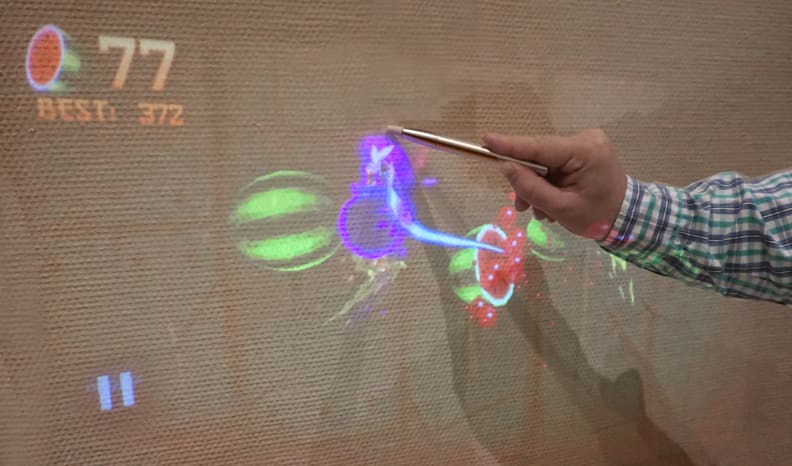Turn Just About Anything into a Touch Screen
After a successful Indiegogo campaign, startup Touchjet gears up to ship the first Android touch-projector.
Products are chosen independently by our editors. Purchases made through our links may earn us a commission.
Touch screens are everywhere these days, and the same holds true at IFA Berlin this week: smartphones, watches, laptops—we even spotted one on a stovetop. But that's not enough for Touchjet.
This startup and recent Indiegogo success story aims to turn any lightly colored flat surface into a touch screen—provided, of course, that you can mount the TouchPico projector nearby.
Undercover computer
At first glance, the palm-sized TouchPico looks just like any other Pico projector on the market. Its attractive form carries all the usual parts, such as the projector lens in the front and the typical ports in the back. But that's about all the TouchPico has in common with its fellow Pico projectors.
The difference is obvious as soon as the device switches on: Rather than simply showing a splash screen of the manufacturer, an Android bootup animation appears. That's right, the Pico isn't just a projector. To call it a projector is actually a bit of a misnomer, because it's really more like an Android computer with a built-in projector.
Viewed as such, the TouchPico somewhat mimics mid-tier android tablets: It houses a 1.6 GHz ARM DUAL Cortex-A9 CPU, 1GB DDR3/4GB NAND Flash memory, 16GB of storage space, two onboard speakers, and a large 4000 mAh Li-polymer battery. The TouchPico is powered by Android KitKat 4.4 and connects to the internet via WiFi, so you can download apps from the Google Play store.
Sensitive to Touch
Obviously, the real draw isn't simply the projector, it's the TouchPico's ability to function as a touchscreen.

A demonstrator plays Fruit Ninja on a wall in the exhibit hall using the TouchPico.
In order to do so, the Touchjet engineers designed a special stylus which emits an IR signal when the tip is depressed. The TouchPico then picks up the location of that signal using a special front-facing camera and translates a touch event. Simple, yet effective; interactions are snappy and accurate.
Bright Lights
Users can still hook up a laptop to use the TouchPico as a projector for meetings or entertainment. It's capable of projecting a clearly visible image at a native resolution of 854x480 pixels, using an RGB LED and WVGA 0.3-inch DLP technology.
Plugged in, the projector throws an image at 80 Lux; but on battery power, energy-saving kicks in, decreasing the output to 50 Lux. This light level yields 80-inch images (16:9) at an acceptable brightness for dark rooms. In the glaring exhibition hall, we saw 25 to 30-inch images at acceptable contrast levels. In particular, a Fruit Ninja demo glowed plenty bright despite the environment's harsh fluorescent lighting.
Finish Line
With 20 days left to go on its Indiegogo campaign, the TouchPico crushed its target of $55,000, raising almost $700,000.
Due to the high support, Touchjet has added an additional stylus for multi-touch support to each TouchPico. The next stretch goal would allow users to turn the TouchPico into a rear-projection device. Intrigued? Head over to their Indiegogo campaign site and pledge. The TouchPico will cost you $599 and ships in October 2014.
{{ photo_gallery name="TouchPico Design" }}
